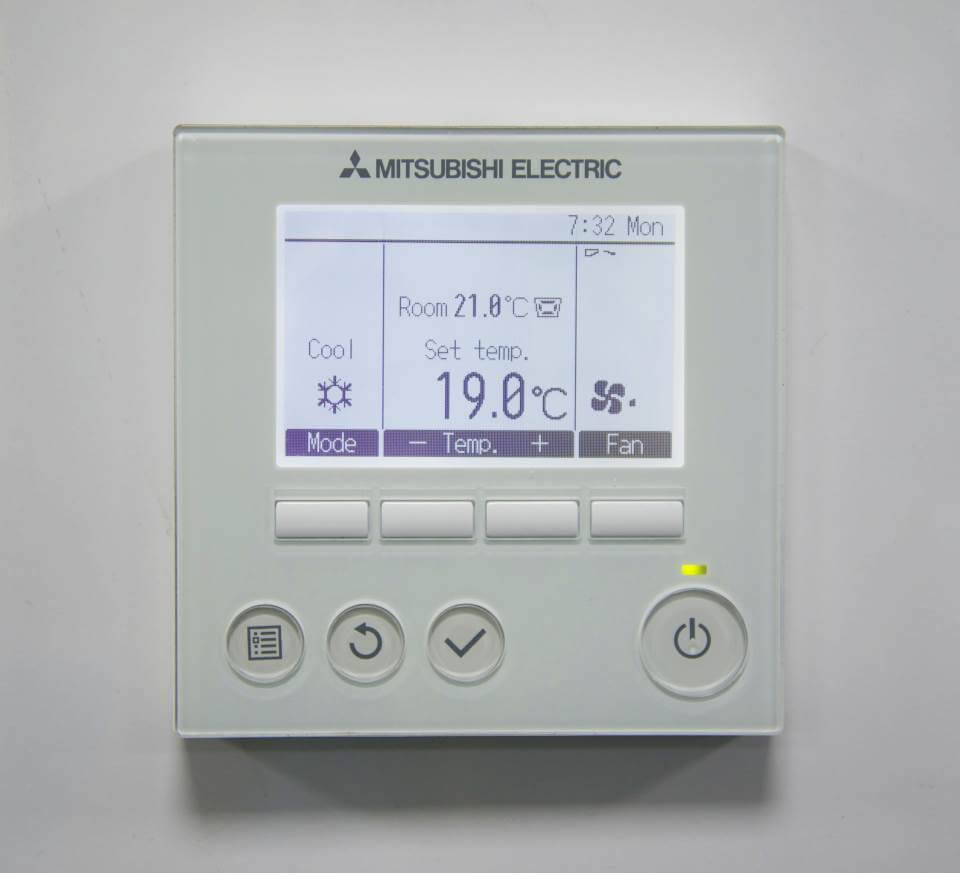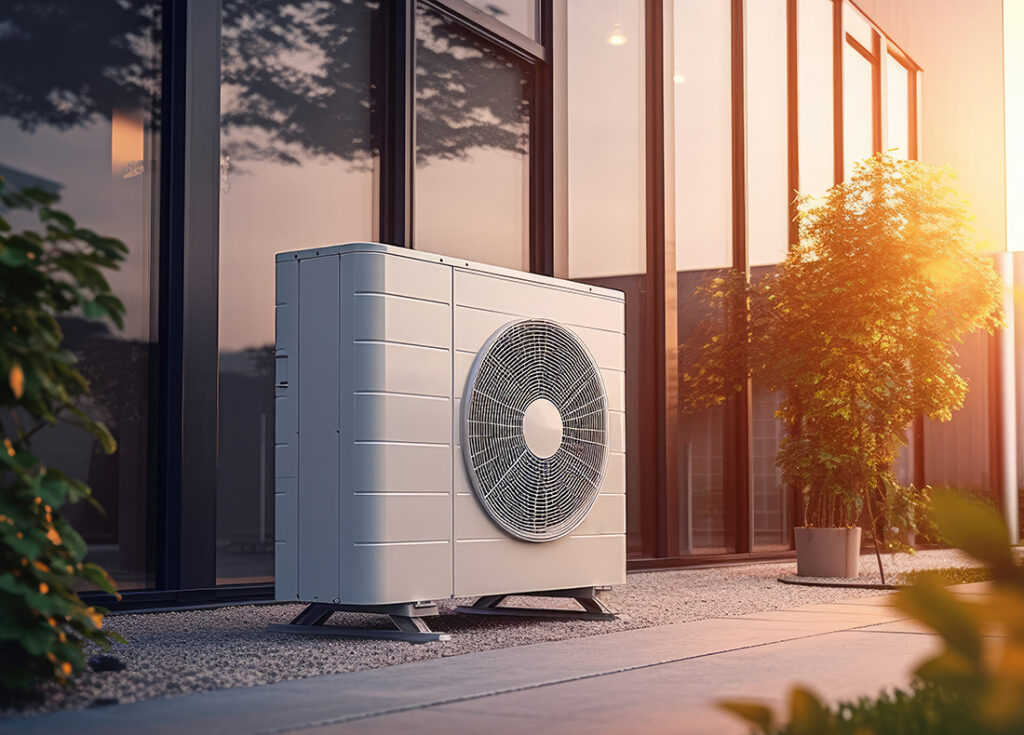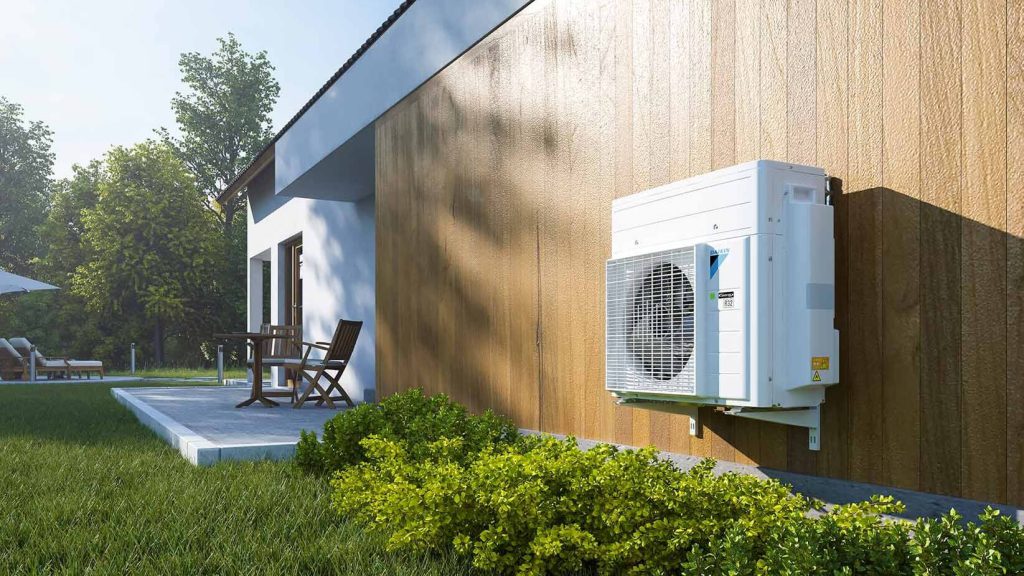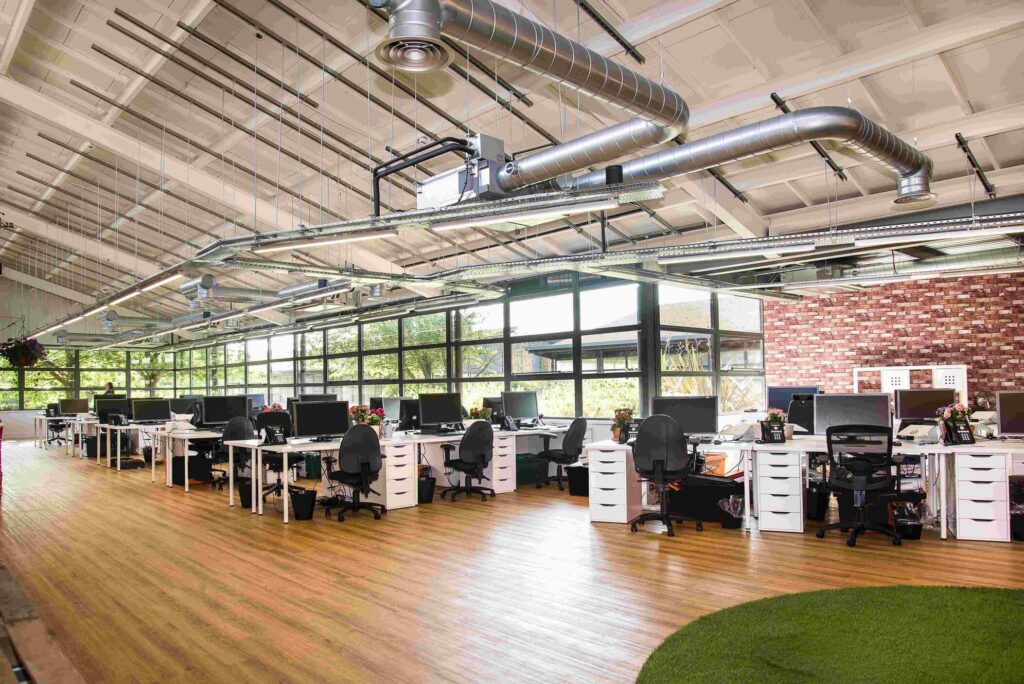Health and Happiness – Why Heating, Ventilation and Air Conditioning Matter

Estimated reading time 11 minutes
According to a number of studies workplace “health and happiness” are contingent on how comfortable the workplace is. There are a number of important factors to consider when it comes to workplace comfort including thermal comfort and air quality.
Thermal Comfort
Thermal comfort, as defined by the UK government, takes into account six basic factors to decide if your workplace has a comfortable temperature.
Thermal comfort factors include air temperature (the temperature of the air surrounding the body in °C), radiant temperature (the heat that radiates from a warm object e.g. workplace equipment that release heat), air movement and speed (the speed of the air moving across a worker can determine how hot or cold a worker is e.g. still or stagnant air can result in workers feeling suffocated, moving air in a warm or humid environment can result in heat loss through convection leaving employees feeling cold and small air movements in cold environments can be perceived as a draught) and humidity (when humidity is high it prevents sweat from evaporating preventing workers from being able to cool down).
Air Quality
The quality of the air in the workplace also plays an important role in workplace comfort. Air pollution can cause health and wellness issues. The air we breathe may contain contaminants if it’s not filtered. These include nitrogen dioxide, sulphur dioxide, ozone, and particles < 2.5µm (PM2.5) and < 10µm (PM10).
Poor Thermal Comfort and Poor Air Quality Impact Health, Wellbeing and Productivity
There is a great deal of evidence that temperature and air quality play vital roles in the workplace and impact workers health, wellbeing, and productivity.
The International WELL Building Institute who are responsible for the concept of the WELL Building Standard, the belief that buildings should be designed with health and wellbeing as a central focus, measures the performance of a building in terms of its impact through air quality, water quality, nourishment, light, fitness, thermal and acoustic controllability and mental and emotional health, grounded in medical research, points to a study which shows that healthier companies outperform their peers. “Tracking the Market Performance of Companies That Integrate a Culture of Health and Safety”. The study concluded that where there is a healthy and safe workforce there is a correlation with a company’s improved performance. The study goes onto say that companies who invest in health and/or safety outperform the S&P 500 in the marketplace.
Too Hot, Too Cold
The Society for Human Resource Management published a CareerBuilder 2010 survey Too Hot! Too Cold! Temperature Affects Productivity of 4,285 workers that found 22% stated a workplace that was “too hot” makes it difficult to concentrate. 11% said the same when it was “too cold”.
A study Effect of Temperature on Task Performance in Office Environment by the Helsinki University of Technology, Laboratory for Heating Ventilating and Air Conditioning in Finland, and the Lawrence Berkeley National Laboratory Environmental Energy Technologies Division at Berkeley found that workplace “performance increases with temperatures between 21°C and 22°C and decreases with temperature above 23°C and 24°C. The highest productivity is at temperature of around 22°C. For example, at the temperature of 30°C the performance is only 91.1% of the maximum , a reduction in performance is 8.9%.”
Cornell University published a paper on the “Study links warm offices to fewer typing errors and higher productivity” and established that the optimal temperature for office productivity is 25°C (77°F). They found that “at 77 degrees Fahrenheit, the workers were keyboarding 100 percent of the time with a 10 percent error rate, but at 68 degrees, their keying rate went down to 54 percent of the time with a 25 percent error rate. From 68 to 77 degrees Fahrenheit, typing errors fell by 44 percent and typing output jumped 150 percent.”
In 2017 HR Magazine reported a survey, carried out by office supply company Fellowes, of 1,000 office workers, and found that 37% of staff were distracted at work because of uncomfortably hot office temperatures and up to 50% said they had lost an hour of work each day due to being distracted. Stephen Bowden a chartered ergonomist at Fellowes said: “One of the main causes of presenteeism is distractions that come in physical, psychological and social forms, which reduces the ability of the person to concentrate on and complete the tasks at hand.”
Loughborough University found that “Productivity drops by 76% throughout the workday when temperatures hit 40°C”. The result of heat stress should not be underestimated. At temperatures of 35°C and 50% humidity there was a 35% decrease in productivity which increased to a 76% reduction when temperatures increased to 40°C and 70% relative humidity.
In a survey conducted by The Facilities Management Journal (FMJ) nearly one third of workers lose productivity due to unsuitable office temperatures. It found that 29% of office workers are unable to work efficiently on average between 10 – 30 minutes a day due to uncomfortable office temperatures. 6% said they lose more than 30 minutes a day of productive working time due to office temperatures not being conducive to working conditions.
The Air We Breathe
The quality of the workplace air can also impact workers.
The Honeywell 2022 Building Occupant Survey Report which looked at 3,000 workers found 89% of those surveyed worry that poor workplace air quality is impacting their health and 62% say they would leave their job if their employer doesn’t take steps to improve air quality in their workplace.
A PubMed article “The effects of indoor air quality on performance and productivity” highlighted a series of experiments which showed that raised indoor pollution can lead to a reduction in productivity by as much as 6-9%.
A View Future Workplace Wellness Study of 1,601 professionals working in offices found that temperature and air quality had the biggest impact on employee health and wellbeing. 50% of those surveyed said poor air quality made them feel tired throughout the workday. Only 33% felt their office had an ideal temperature and 33% lost 60+ minutes of work per day due to physical and environmental factors.
A paper published by Harvard T H Chan School of Public Health, in 2021 found that “Office air quality may affect employees’ cognition, productivity”. The one year study established that “increased concentrations of fine particulate matter (PM2.5) and lower ventilation rates (measured using carbon dioxide (CO2) levels as a proxy) were associated with slower response times and reduced accuracy on a series of cognitive tests.” The paper further states that “researchers noted that they observed impaired cognitive function at concentrations of PM2.5 and CO2 that are common within indoor environments.” Jose Guillermo Cedeño Laurent, a research fellow in the Department of Environmental Health and lead author of the study said: “The study confirmed how low ventilation rates negatively impact cognitive function. Overall, the study suggests that poor indoor air quality affects health and productivity significantly more than we previously understood.”
In another paper “Indoor Air Quality and Cognitive Performance” the causal impact of indoor air quality on the cognitive performance of individuals using data from official chess tournaments found an increase in the indoor concentration of fine particulate matter (PM2.5) by 10 μg/m3 increased a player's probability of making an erroneous move by 26.3%.
What Is The Cost of Discomfort In The Workplace To UK Businesses?
UK businesses could be losing approximately £23 billion annually (assuming an average wage of £34,963 (published May 2024); 33 million UK employees (in the three months to March 2024) and a 252 day working year) when there is thermal discomfort and air quality issues.
It’s clear air temperature and air quality can have a major impact on workers productivity if they are not controlled within the workplace and there is a significant cost to employers in terms of employee health and wellness and to business productivity. That’s why heating, ventilation, and air conditioning (HVAC) matter in the workplace.
How Can Heating, Ventilation and Air Conditioning Help?
HVACs come with many benefits and can help to tackle many of the temperature and air quality issues mentioned throughout this article. These include:
Temperature Control
An HVAC system enables you to take control of the temperature within your building irrespective of whether the outside temperature is hot or cold. When the workplace gets too hot or too cold it’s more than just an issue about comfort. Too high and too cold temperatures can become a health and safety issue leading to dizziness, fainting, heat cramps, heat stroke or collapse at high temperatures. Low temperatures can result in a loss of concentration and increased tiredness, which means that workers are more likely to put themselves or others at risk when temperatures are low.
An HVAC allows you to set a comfortable temperature for the building occupants and helps to provide a comfortable working environment.
Humidity Control
Just like high and low temperature, high and low humidity can also have health implications.
High humidity can lead to the growth of mould (also known as mildew). Mould reproduces through spores. These spores are small enough that they are invisible to the naked eye and can float round in the air and attach themselves or spread to other surfaces. Given the right conditions spores can form new mould colonies. Once in the air mould spores can cause a variety of symptoms including allergic reactions such as eye irritation, nasal issues and general itchiness as well as respiratory problems when breathed in.
A lack of humidity control can also result in overheating as the body’s normal way of cooling down is impeded. In normal conditions our body produces sweat, sweat evaporates to release body heat. When the surrounding air contains high amounts of water vapour it’s harder for sweat to evaporate as the air already has a high moisture content and can’t absorb any more water. As a consequence, our body is unable to release the heat and we become hotter, skin becomes clammy, and damp and we become more and more uncomfortable.
Just as air conditioning removes the heat from the air, it also removes humidity too, allowing you to control the humidity in a building.
Ventilation
It’s not only UK law to ensure good ventilation in workplaces we also know from numerous research studies that good ventilation is essential when it comes to employee health and well-being.
An HVAC system ensures there is always fresh or purified air in the working environment.
Air Purification
Air conditioning plays a major role in keeping the air clean within a workplace. Air conditioners come equipped with filtration and where requested, purification technologies can be installed, which filter and clean the air they take in. As long as an air conditioner is properly taken care of, filters are cleaned or replaced as required and the system is well maintained then your air conditioner will filter out allergens, particulates, dust, germs and contaminants.
Without an air conditioning system many people resort to opening windows which can allow pollen and other irritants to find their way into your office or building.
Having an HVAC allows for controlled temperature and humidity and good indoor air quality which supports better health and staff wellness. Staff are less likely to be sick die to allergies or respiratory illnesses. Employees will be more comfortable allowing them to focus on their work and their mental health will be improved as they’ll be working in a less stressful environment. We also know that improved air quality improves cognition and decision making leading to improved productivity, efficiency, and ROI.
Expert Heating, Ventilation and Air Conditioning Design and Installation, Advice and Support
Synecore is an expert in HVAC design and installation in Kent, London, Surrey, Sussex, Essex. We are at the forefront of technological changes in the HVAC industry.
We provide the installation of high-quality products from leading manufacturers. We offer our customers value and long-term warranties when you sign up to our planned preventative maintenance plan that offers complete peace of mind. At Synecore we offer the best solutions for your air conditioning installation.
It’s worth noting that, unlike many independent heat pump installers, Synecore offers both design and installation. Both elements are critical to the effectiveness of your new heating system, but not all contractors have the in-house facilities to offer both.
If you are looking to install a new air conditioning installation or need to replace an old system, contact our team or call on 01795 509 509. We’ll talk you through your options and provide you with expert advice on the right office air conditioning system for you.



